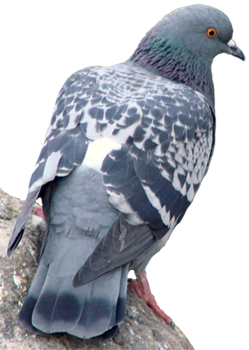
9. X-Pigeons |
||||
C - Checker
 There
are four main pigeon patterns: Barless
(c), Bar (C+), Checker (C), and T-pattern
Checker (CT). Recessive
pattern to the T-pattern check is called checker (gene
symbol C), showing several
triangular checks of light gray or "blue" in the blacker
wing shield area (See picture on the left). The word check originates
from the so-called checked appearance of the wing. This condition is
caused by the presence of two black marks situated respectively in
the inner and outer vanes of the wing coverts, the central and proximal
portions of which are blue. The rest of the plumage of checked birds
is blue with the invariable exception of a black terminal band on the
tail and of the not infrequent presence of checks on the upper back.
The rump may be either very light, almost white, or a shade of blue
uniform with that of the wing coverts, or any shade between these two
colors. According to Sarah van Hoosen Jones (1921), somewhat similar
checked patterns are found in Columba guinea and many of the doves
(mourning doves, ground doves, etc.); in fact a large number of the
individuals of the order Columbae exhibit checks. The genetic behavior
of the checks of Columba livia and of the doves are probably caused
by the analogous mutation at the same spot on the chromosome. Since
all Columbae are related evolutionarily, major parts of their genomes
expected to be identical. The
wing bars on checker pattern are usually wider than the barred birds
when some checkers show the wing-bars while some do not. The T-pattern
check, check and the bar patterns actually intergraded, possibly from
modifying factors or more likely from intermediate alleles. According
to Hollander, the checker pattern has been subdivided according to
the amount of spreading into several sub-types. Thus, Hollander identified
two additional checks in the pattern series: dark checker (CD)
which comes inbetween T-pattern check and check, and the light checker
(CL), which comes inbetween
check and bar patterns. I will purposely neglect these additional pattern
alleles for the time being, because not much is known or reported about
them. It seems for an allelic series like pattern to have many different
phenotypes, where we know of at least six alleles might be caused by
not genes and very likely with a large dose of epigenetics. Nevertheless,
one can almost always distinguish these different check patterns in
pigeons.
There
are four main pigeon patterns: Barless
(c), Bar (C+), Checker (C), and T-pattern
Checker (CT). Recessive
pattern to the T-pattern check is called checker (gene
symbol C), showing several
triangular checks of light gray or "blue" in the blacker
wing shield area (See picture on the left). The word check originates
from the so-called checked appearance of the wing. This condition is
caused by the presence of two black marks situated respectively in
the inner and outer vanes of the wing coverts, the central and proximal
portions of which are blue. The rest of the plumage of checked birds
is blue with the invariable exception of a black terminal band on the
tail and of the not infrequent presence of checks on the upper back.
The rump may be either very light, almost white, or a shade of blue
uniform with that of the wing coverts, or any shade between these two
colors. According to Sarah van Hoosen Jones (1921), somewhat similar
checked patterns are found in Columba guinea and many of the doves
(mourning doves, ground doves, etc.); in fact a large number of the
individuals of the order Columbae exhibit checks. The genetic behavior
of the checks of Columba livia and of the doves are probably caused
by the analogous mutation at the same spot on the chromosome. Since
all Columbae are related evolutionarily, major parts of their genomes
expected to be identical. The
wing bars on checker pattern are usually wider than the barred birds
when some checkers show the wing-bars while some do not. The T-pattern
check, check and the bar patterns actually intergraded, possibly from
modifying factors or more likely from intermediate alleles. According
to Hollander, the checker pattern has been subdivided according to
the amount of spreading into several sub-types. Thus, Hollander identified
two additional checks in the pattern series: dark checker (CD)
which comes inbetween T-pattern check and check, and the light checker
(CL), which comes inbetween
check and bar patterns. I will purposely neglect these additional pattern
alleles for the time being, because not much is known or reported about
them. It seems for an allelic series like pattern to have many different
phenotypes, where we know of at least six alleles might be caused by
not genes and very likely with a large dose of epigenetics. Nevertheless,
one can almost always distinguish these different check patterns in
pigeons.